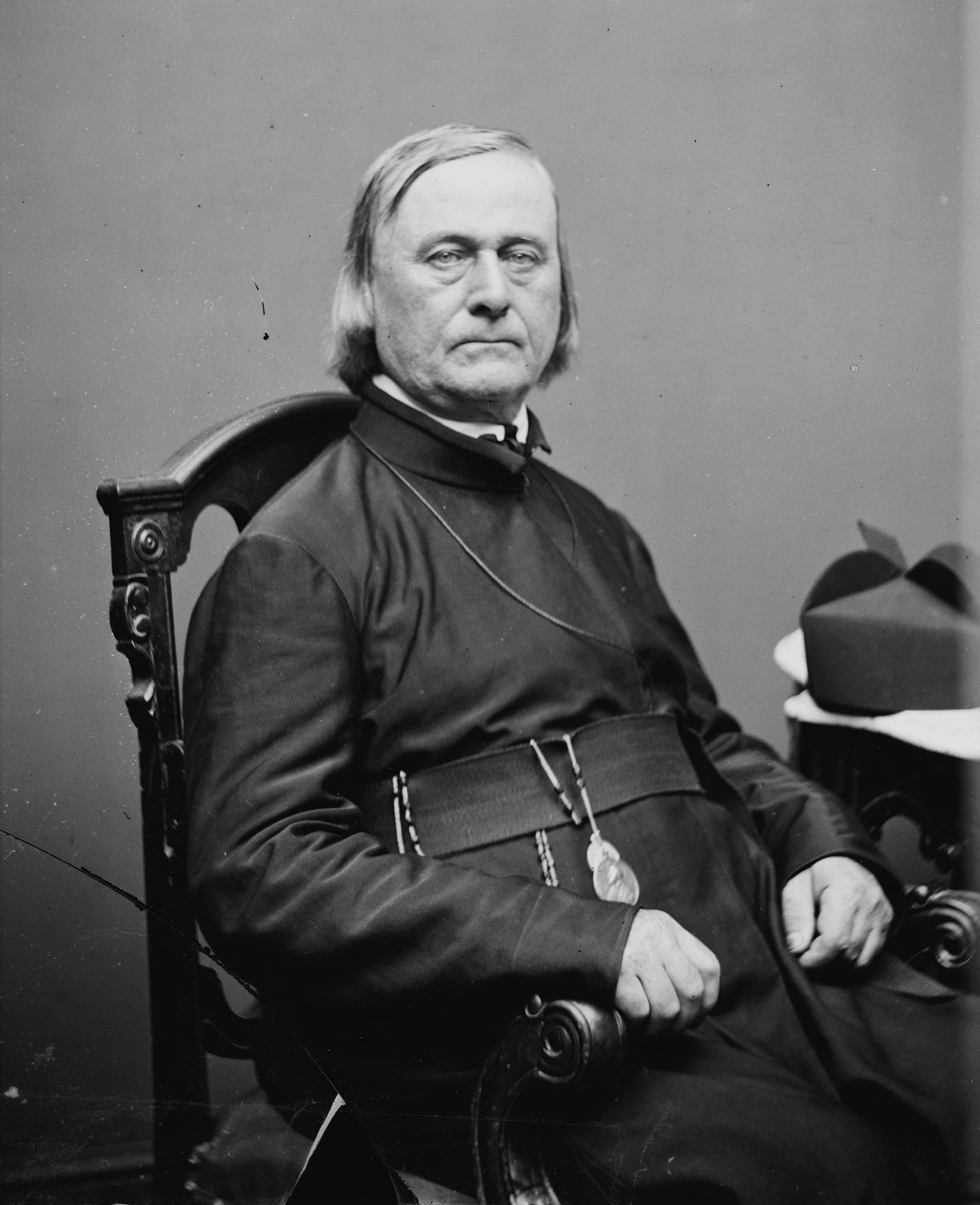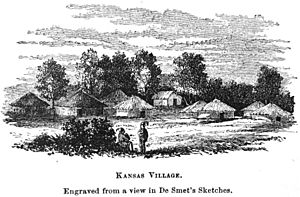Pierre-Jean De Smet facts for kids
Quick facts for kids Pierre-Jean De Smet |
|
 c. 1860-65, by Mathew Brady |
|
| Born | 30 January 1801 in Dendermonde, French First Republic (now Belgium) |
|---|---|
| Died | 23 May 1873 (aged 72) in St. Louis, Missouri |
| Church | Catholic |
| Other names | Pieter-Jan De Smet |
| Education | White Marsh Novitiate, present-day Bowie, Maryland |
| Ordained | 23 September 1827 |
Pierre-Jean De Smet, also known as Pieter-Jan De Smet, was a Flemish Catholic priest and a member of the Society of Jesus (Jesuits). He was born on January 30, 1801, and passed away on May 23, 1873.
De Smet is famous for his important work in the mid-1800s. He traveled widely as a missionary to help and teach Native American communities. His work took him across the midwestern and northwestern United States, and into western Canada.
He traveled an amazing 180,000 miles during his life. Native Americans called him De Grote Zwartrok, which means The Great Black Skirt, because of his black Jesuit robes. He was also known as "Friend of Sitting Bull" because he helped convince the Sioux leader to talk with the American government. These talks led to the 1868 Treaty of Fort Laramie.
Contents
Early Life and Training
Pierre-Jean De Smet was born in 1801 in Dendermonde, a town in what is now Belgium. When he was 19, he began his religious studies at the Petit Séminaire in Mechelen.
In 1821, De Smet came to the United States with eleven other Belgian Jesuits. They all wanted to become missionaries to Native Americans. He started his training as a Jesuit at White Marsh, an estate near Baltimore, Maryland. Part of this old estate is now Sacred Heart Church in Bowie.
Becoming a Priest
In 1823, De Smet moved to Florissant, Missouri, which is just north of St. Louis. Here, he continued his studies to become a priest and began learning Native American languages. He was officially made a priest on September 23, 1827.
De Smet and five other Jesuits helped start several schools in Florissant. One of these was the St. Regis Seminary. This is where De Smet first met Native American students. He learned a lot about their customs and languages while working at the seminary.
Around 1830, De Smet moved to St. Louis to work as a treasurer at the College of St. Louis. He became an American citizen on September 23, 1833. Later that year, he returned to Belgium because he was not feeling well. He came back to St. Louis in 1837.
Mission Work in Iowa
In 1838 and 1839, De Smet helped create St. Joseph's Mission. This mission was in what is now Council Bluffs, Iowa. It was in the land of the Potawatomi people, who had moved west from Illinois.
De Smet used an old military fort building for the mission. He worked mainly with a Potawatomi group led by Billy Caldwell, also known as Sauganash. Caldwell was a very important leader who spoke several languages.
De Smet was very upset by the violence and problems caused by the alcohol trade among the Native American people. During this time, he also helped Joseph Nicollet create maps of the Upper Midwest. De Smet used his own mapping skills to make the first detailed map of the upper Missouri River valley. This map showed Native American villages and other important places.
First Missionary Journey
The Salish Native Americans, who had heard about Christianity, sent groups to St. Louis. They traveled over 1,500 miles to ask for "black-robes" (Catholic priests) to come and help their people. They hoped a new religion might help them with illnesses.
After three groups faced difficulties, a fourth group met De Smet in 1839. De Smet felt this meeting was very important. He went with the Salish group to St. Louis and asked the Bishop to send missionaries. The Bishop asked De Smet to go to the Salish territory to start a mission.
On July 5, 1840, Father De Smet held the first Mass in Wyoming. This was near the town of Daniel. When De Smet arrived at Pierre's Hole, 1,600 Salish and Pend d'Oreilles people welcomed him. He baptized 350 people. Then, he went back to the eastern United States to raise money for the mission.
Establishing Missions
In 1841, De Smet returned to the Salish people with two other priests and three friars. They started St. Mary's Mission in the Bitterroot Valley. They worked with the Salish for several years.
De Smet also visited other missionaries. He noticed that the Nimíipuu (Nez Perce) people were careful about Catholicism because of Protestant missionaries. He convinced some Nimíipuu to stay at St. Mary's for two months, and they all received baptism before leaving.
De Smet asked the American public for money to help his missionary work. He believed that the Salish people needed to settle in villages and learn farming to make lasting changes. He wanted them to have tools, cattle, and seeds. He then went to France to find more helpers. He returned to the Pacific Northwest in 1844 with five more Jesuits and a group of nuns.
Exploring the Canadian Rockies (1845-1846)
One of De Smet's longest trips started in August 1845. He explored the area west of the Rockies, which was claimed by both Americans and the British. De Smet began his journey from Lake Pend Oreille in Idaho. He traveled north along the Kootenay River Valley. He then crossed over to Columbia Lake, which is where the Columbia River begins.
He followed the upper Columbia valley north past Lake Windermere. At Radium Hot Springs, he turned east and crossed Sinclair Pass back into the Kootenay River Valley. He put up a large wooden cross at the top of Whiteman's Pass, which is why the Cross River got its name.
On the other side of the Great Divide was British land. From the pass, streams led to the Spray River, which joins the Bow River near Banff, Alberta. De Smet went upstream along the Bow River to its source, Bow Lake. He traveled even further north to the Saskatchewan River, which he followed downstream.
It was October, and winter was coming when he reached Rocky Mountain House. He had met his goal of meeting the Cree, Chippewa, and Blackfoot people. He then traveled to Fort Edmonton, where he spent the winter of 1845–1846.
During these years, he also started St. Mary's Mission in Victor, Montana, for the Flathead and Kootenay tribes. He also founded the Sacred Heart Mission for the Coeur d'Alene people in Cataldo, Idaho. In the spring of 1846, De Smet began his journey back. He traveled west to Jasper House and then crossed the Great Divide at Athabaska Pass. He eventually reached Fort Vancouver and then returned to his mission at Sainte-Marie.
Later Years and Passing
In 1854, De Smet helped start the mission in St. Ignatius, Montana. This mission is on the Flathead Indian Reservation. The main building there was added to the National Register of Historic Places 100 years after De Smet's death.
In his final years, De Smet worked to support the missions he had helped create. He traveled back to Europe eight times to raise money for these missions. In 1868, he convinced Sitting Bull to send a group to meet with U.S. peace leaders. This meeting led to the Treaty of Fort Laramie.
De Smet returned to St. Louis and continued to make trips north to help Native Americans and teach Christianity. He often traveled on steamboats, sometimes with his friend Joseph LaBarge, a steamboat pilot who helped the Catholic missions. Pierre-Jean De Smet passed away in St. Louis on May 23, 1873. He was buried at Calvary Cemetery in St. Louis.
De Smet's Legacy
Pierre-Jean De Smet's writings and travel stories about his work with Native American nations are kept in two main places:
- The Jesuit Archives in St. Louis, Missouri.
- The Pierre Jean De Smet Papers at the Washington State University archives in Pullman, Washington.
His life and work have been featured in art exhibits:
- Crossing the Divide: Jesuits on the Frontier (2010) at the St. Louis University Museum of Art.
- A Complex Vision: De Smet and the American Frontier (2014–2015) also at the St. Louis University Museum of Art.
In 1968, he was honored by being added to the Hall of Great Westerners at the National Cowboy & Western Heritage Museum.
Places Named After De Smet
Many places are named to honor Pierre-Jean De Smet:
- De Smet, Idaho, a town.
- Tensed, Idaho, a nearby town. Its founders wanted to name it De Smet, but the name was taken. They tried to spell it backward, and a mistake changed the "m" to an "n."
- DeSmet, Montana, a town between Wye and the Missoula International Airport.
- DeSmet Junction, near Wye, where major roads meet.
- De Smet, South Dakota, which was the childhood home of famous author Laura Ingalls Wilder.
- De Smet Jesuit High School in Creve Coeur, Missouri.
- De Smet Range and Roche de Smet in Canada.
- Lake Desmet, located between Buffalo and Sheridan, Wyoming.
- DeSmet Hall, a large and old men's residence hall at Gonzaga University in Spokane, Washington.
- DeSmet Hall, a first-year residence hall at Regis University in Denver, Colorado.
See also
 In Spanish: Pierre-Jean de Smet para niños
In Spanish: Pierre-Jean de Smet para niños
- Red Fish, an Oglala chief




